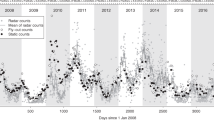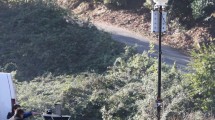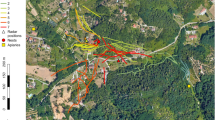Abstract
THE possibility of detecting flying locusts by radar was examined theoretically some years ago, using the deduction of Ryde1 that the intensity of a centimetric radar echo from raindrops is proportional to ∑ND 6, where N is the number of drops of diameter D per unit volume. Raindrops do not exceed about 6 mm. in diameter; and recorded rainfall intensities indicate that there can rarely be more than ten such drops per cubic metre in the heaviest precipitation. More than half the weight of a locust is water; from considerations of water-content alone, a swarm averaging ten flying locusts per cubic metre, as recorded in the Kenya Highlands in 19452, with each locust containing about 1 c.c. of water, might be expected to give an echo of intensity at least an order of magnitude greater than that given by the very heavy precipitation considered; and it was concluded that recognizable echoes might well be given by much more attenuated swarms. Subsequent field-work3,4 has suggested that considerably lower volume densities, of the order of 0.1 locust per cubic metre, are in fact more representative of even the denser parts of flying swarms; densities of this order, however, might still be expected to give echoes comparable with those given by heavy precipitation.
Similar content being viewed by others
Article PDF
References
Ryde, J. W. (1946), in Jones, R. F., Quart. J. Roy. Met. Soc., 76, 312 (1950).
Gunn, D. L., Perry, F. C., et. al., Anti-Locust Bull., No. 3 (1948).
Rainey, R. C., and Sayer, H. J., Nature, 172, 224 (1953).
Waloff, Z., et al., unpublished field data (1951–54).
Pumphrey, R. J., in Kennedy, J. S., Phil. Trans. Roy. Soc., B, 235, 226 (1951).
Rainey, R. C., and Ashall, C., Brit. J. Anim. Behav., 1, 136 (1953)
Overseas Supplement to the Daily Weather Report of the Meteorological Office, London, Nos. 1177–1178.
Durst, C. S., Meteorological factors in radio wave propagation, Phys. Soc. and Roy. Met. Soc., p. 193 (1946).
Author information
Authors and Affiliations
Rights and permissions
About this article
Cite this article
RAINEY, R. Observation of Desert Locust Swarms by Radar. Nature 175, 77 (1955). https://doi.org/10.1038/175077a0
Issue Date:
DOI: https://doi.org/10.1038/175077a0
Comments
By submitting a comment you agree to abide by our Terms and Community Guidelines. If you find something abusive or that does not comply with our terms or guidelines please flag it as inappropriate.



